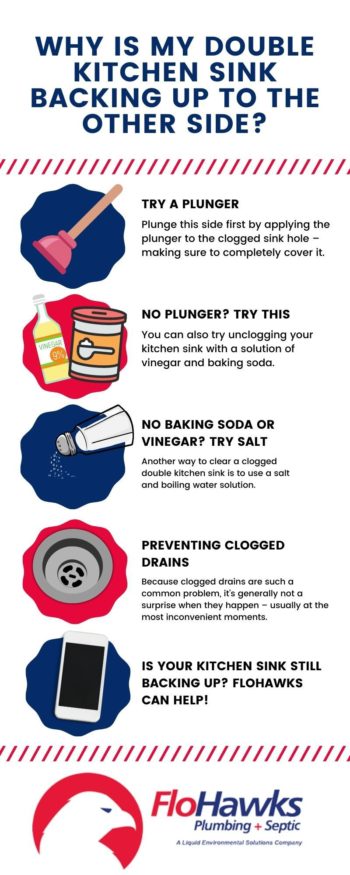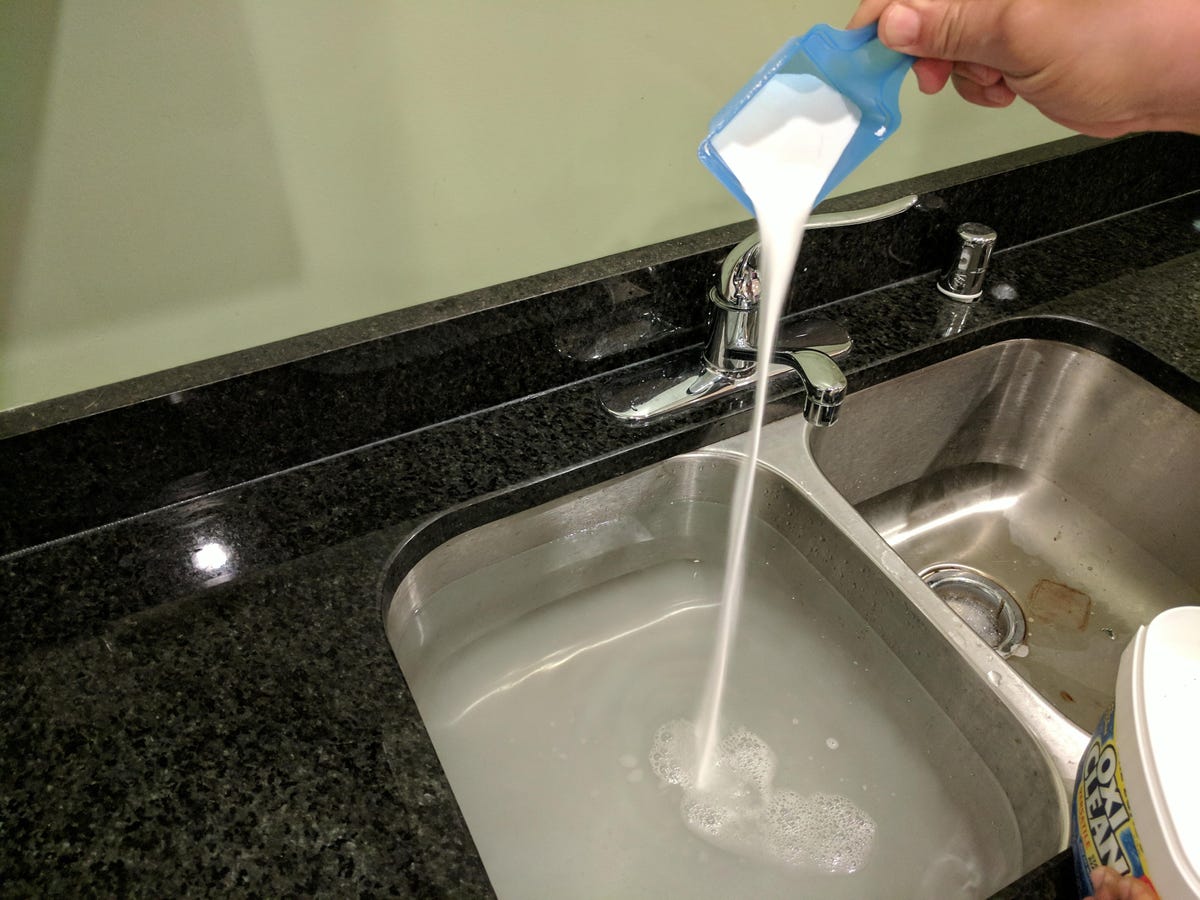To unclog a double kitchen sink with standing water, start by using a plunger on both drains. If plunging fails, apply a mixture of baking soda and vinegar, then flush with hot water.
Dealing with a clogged double kitchen sink filled with water can be a daunting task. A blocked sink disrupts daily household activities and requires immediate attention. The key to tackling this problem is to act quickly and efficiently, using tools and household items effectively.
A plunger often serves as the first line of defense, creating enough suction to dislodge minor blockages. For more stubborn clogs, a combination of natural cleaners like baking soda and vinegar can break down the obstruction without damaging your pipes. Ensuring your kitchen sink is free from blockages not only maintains a clean and functional space but also prevents potential plumbing disasters. By following these steps, you can restore your sink to proper working order and keep your kitchen running smoothly.
Introduction To Double Kitchen Sink Clogs
A double kitchen sink clog can turn a routine day upside down. As the heart of the home, a kitchen should be a place of functionality and cleanliness. However, when your double sink stands filled with water, stress levels can rise. Understanding the common causes of sink blockages and the impact of standing water is crucial. It can help you quickly return your kitchen to its pristine state.
Common Causes Of Sink Blockages
Double kitchen sinks often face blockages due to a variety of factors:
- Food particles that shouldn’t go down the drain.
- Grease buildup that solidifies in pipes.
- Foreign objects accidentally dropped in.
- Soap scum accumulation from dishwashing.
Each cause can contribute to a slow draining or completely blocked sink.
The Impact Of Standing Water
Standing water in your sink can lead to several issues:
| Problem | Impact |
|---|---|
| Foul odors | Unpleasant smells fill your kitchen. |
| Bacteria growth | Health risks increase with waterborne pathogens. |
| Structural damage | Water can damage your sink and cabinets over time. |
Immediate action is necessary to prevent these impacts from worsening.

Credit: www.angi.com
Initial Assessment
Before fixing a double kitchen sink with standing water, an initial assessment is crucial. This step ensures a safe and effective approach to unclogging. Let’s dive into the key components of this assessment.
Safety First: Preparing To Tackle The Clog
- Wear gloves to protect your hands from dirt and harm.
- Ensure the area is well-lit and ventilated.
- Turn off the water supply to avoid any unexpected water flow.
Identifying The Severity Of The Blockage
Understanding the blockage level helps decide the next steps. Here are some signs:
| Severity | Signs |
|---|---|
| Mild | Water drains slowly. |
| Moderate | Water stands for hours. |
| Severe | Water does not drain at all. |
After the assessment, you can choose the right tools and methods for unclogging.
Simple Home Remedies
Simple Home Remedies can turn the tide in your battle against a clogged double kitchen sink. These methods are safe, easy, and use common household items.
Boiling Water Technique
One of the quickest fixes uses something you always have at home: hot water. Follow these steps:
- Boil a kettle of water.
- Carefully pour it down the drain.
- Wait a few minutes.
- Run tap water to check the flow.
Repeat if needed. The heat can break down simple blockages.
Natural Solutions: Vinegar And Baking Soda
This dynamic duo often succeeds where others fail. Here’s how to use them:
- Pour a cup of baking soda into the drain.
- Follow with a cup of white vinegar.
- Cover the drain to trap the reaction.
- Wait for 15 minutes.
- Flush with hot water.
These ingredients create a fizzing action that can dislodge gunk.
Manual Unclogging Methods
Double kitchen sinks can be a challenge when clogged. Standing water signals a blockage. Quick manual methods can restore flow. Below, learn to use common tools for this task.
Plunger Power: A Step-by-step Guide
Begin with a simple plunger. It’s effective and safe for pipes.
- Fill the sink with enough water to cover the plunger’s head.
- Seal the other sink’s drain with a wet cloth.
- Place the plunger over the clogged drain.
- Pump firmly, applying steady pressure.
- Check for water flow improvement.
- Repeat if necessary until the clog clears.
Often, plunging alone can dislodge the blockage.
Plumbing Snake: How To Use It Effectively
A plumbing snake reaches deeper clogs beyond the plunger’s reach.
- Insert the snake into the drain.
- Turn the handle clockwise.
- Feel for resistance indicating a clog.
- Push and twist to break up the blockage.
- Pull the snake out to remove debris.
- Run hot water to clear remaining residue.
Repeat these steps if the sink still drains slowly.
Chemical Drain Cleaners
Dealing with a clogged double kitchen sink filled with standing water can be frustrating. One effective solution is using chemical drain cleaners. These powerful agents dissolve the gunk blocking your pipes. Yet, picking and applying the right cleaner is crucial for success. This section guides you through selecting and using chemical cleaners efficiently.
Selecting The Right Chemical Cleaner
Not all chemical cleaners work the same way. Some target grease, while others dissolve hair or food particles. For kitchen sinks, you’ll want a formula that’s tough on grease and food waste. Look for products labeled for kitchen use or those that specify grease treatment. Always check the cleaner is safe for your type of plumbing. Older pipes may need a gentler formula.
- Read labels carefully to match the cleaner with your clog type.
- Choose eco-friendly options to minimize environmental impact.
- Ensure the product is safe for your pipes to prevent damage.
Application Tips For Maximum Efficiency
Correct application ensures the cleaner works well and protects your plumbing. Always wear gloves and goggles for safety. Open windows for ventilation. Follow these steps for the best results:
- Pour the cleaner directly into the drain. Avoid splashing.
- Use the recommended amount. More isn’t always better.
- Wait the specified time on the product label before flushing with hot water.
- Repeat if needed, but avoid overuse to prevent pipe damage.
Remember, patience is key. Give the chemical time to work through the clog. If the sink remains clogged after two attempts, consider a different approach or call a professional. Chemical cleaners are effective, but not all clogs respond to chemicals.
Advanced Techniques
Dealing with a double kitchen sink full of standing water can be daunting. Sometimes, a plunger or a simple baking soda and vinegar mix won’t do the trick. That’s where advanced techniques come into play. These methods go beyond basic fixes, targeting stubborn clogs deep within your plumbing. Let’s explore some of these powerful approaches that can help you clear that blockage efficiently.
Wet/dry Vacuum Approach
One effective tool for unclogging sinks is a wet/dry vacuum. Unlike plungers, this device can apply significant suction to remove clogs. Here’s how to use it:
- Set the vacuum to wet mode.
- Cover overflow holes in the sink.
- Seal the vacuum hose against the drain.
- Turn on the vacuum to suck out the clog.
This method often pulls up the clog and clears the sink quickly.
Disassembling The P-trap
The P-trap is the curved pipe beneath your sink. Clogs often lodge here. To disassemble the P-trap:
- Place a bucket under the P-trap.
- Unscrew the connectors using a wrench.
- Remove the P-trap and clean it out.
- Reattach the P-trap securely.
Cleaning the P-trap may resolve the clog completely.
Prevention Strategies
Prevention Strategies play a key role in keeping your double kitchen sink clear. Before facing a clog, adopt habits that maintain free-flowing drains. Two main areas need attention: Regular Maintenance and Best Practices for Sink Usage.
Regular Maintenance Tips
Consistent care prevents sink blockages. Here’s how:
- Weekly hot water flush: Pour boiling water down the drain.
- Baking soda and vinegar: Use this natural combo monthly.
- Enzyme cleaners: Apply bi-monthly for organic buildup.
- Strainer cleaning: Remove debris from sink strainers regularly.
Best Practices For Sink Usage
Proper sink use prevents clogs:
- Avoid grease: Keep fats out of the sink.
- Scrap leftovers: Toss food scraps in the trash, not the sink.
- Use strainers: Catch solids before they enter the drain.
- Run water: Always do this when using the garbage disposal.

Credit: flohawks.com
When To Call A Professional
Sometimes, a clogged double kitchen sink needs expert hands. Recognize when DIY methods fail. Professionals have the right tools and expertise. Don’t risk further damage to your plumbing.
Recognizing Stubborn Clogs
Some signs tell you to stop and call a pro:
- Water remains despite efforts
- Bad smells linger
- Strange noises come from pipes
- Multiple attempts at unclogging fail
These signs point to a deep clog. Pros handle these well.
Finding A Reliable Plumber
Choose a plumber like you pick a doctor:
- Seek recommendations from friends
- Read online reviews carefully
- Ensure they’re licensed and insured
- Ask about their experience with kitchen sinks
A good plumber saves time, stress, and money. They fix clogs fast and right.

Credit: www.cnet.com
Frequently Asked Questions
Can Baking Soda Unclog A Kitchen Sink?
Baking soda, followed by vinegar, can often dissolve minor clogs. Pour a cup of baking soda down the drain, wait a few minutes, add an equal amount of vinegar, and rinse after the fizzing subsides.
What Causes Double Sinks To Clog?
Grease, food particles, and soap scum are common culprits that build up over time, leading to obstructed pipes connecting double kitchen sinks.
How To Unclog A Sink With Standing Water?
Begin by removing the standing water using a cup or a small container. Then, attempt plunging or applying a mixture of baking soda and vinegar to break up the clog.
Will A Plunger Work On A Double Sink?
Yes, a plunger can work effectively on a double sink. Seal off the second sink’s drain with a stopper or wet cloth, and plunge vigorously on the clogged side.
Is Professional Help Needed For Double Sink Clogs?
For simple clogs, DIY methods often suffice. However, persistent or severe blockages may require professional plumbing services to ensure proper resolution without damaging pipes.
Conclusion
Tackling a double kitchen sink full of standing water can be daunting, yet it’s manageable with the right steps. By following the tips outlined, you’ll ensure your sink is free-flowing again. Remember, regular maintenance prevents future clogs. Here’s to a cleaner, more efficient kitchen sink!

